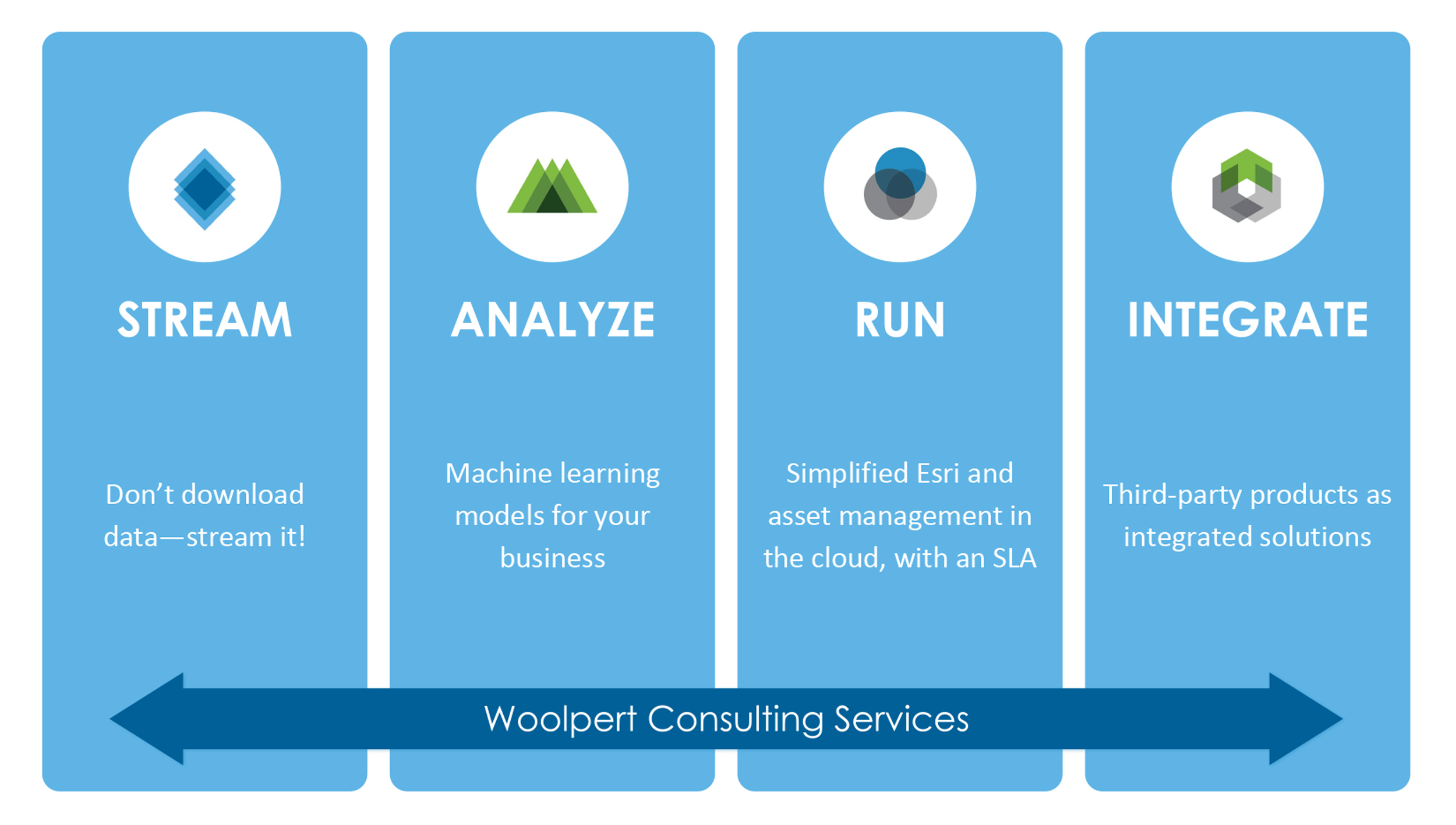
BLOG
—
I Have a Cloud Strategy. Now What?
If you are a chief information officer (CIO)—or its more externally facing counterpart, the chief technology officer (CTO)—then it’s highly likely that you have already developed a strategy for consuming cloud technology. Strategies are nuanced for each organization, but there are common themes:
- Hybrid cloud vs. multi-cloud vs. all-in
- Cloud-first vs. on-prem first
- Serverless vs. more self-managed
- And, of course, business-specific considerations around security and privacy policies
These basic technical and governance considerations have remained fairly consistent over time. See Gartner’s 2019 guidelines for developing a cloud strategy and CIO magazine’s 2020 look ahead for representative examples.
Woolpert’s Cloud Solutions Strategy
As the Woolpert team considered how to deliver Woolpert Cloud Solutions, our strategy coalesced around four pillars that reflect our business objective to “shift clients to the geospatial cloud.” These pillars are:

A series of policies and patterns flowed from our strategic pillars that support our business objective. Of course, we have a team of business and technical leaders who have done this before and a team of seasoned professionals who can implement our product and service strategy, so execution seems more attainable. But still, it takes work!
Assess, Plan, Deploy, Optimize
But what about you? How can you move from strategy to execution? Where do you start?
These are very common questions that have arisen from client engagements. Regardless of the level of maturity of a client’s cloud strategy, we ask them and ourselves: “Where does the current project or program sit in a cloud delivery model?”
It may seem obvious, but listening is the first step. By hearing what our clients are saying when they talk about their cloud program or project, we can determine the right approach. Here are some of the concerns we listen for:
- Is the CIO expressing concern that budgets for existing cloud programs are out of control and/or exceeding plans? That means it’s time to Optimize.
- Is a hardware end-of-life concern forcing an aggressive lift-and-shift push for a critical application? Then it’s time to Plan and Deploy.
- Is an IT director taking the first steps in implementing a strategy? It might be time to Assess technology.
With practice, this process of determining the needed approach becomes second nature. And you’ve probably already realized that most organizations fall into one or more of these phases at the same time. It’s not unusual for an IT department to be actively rolling out a new collaboration suite while the COO is still figuring out whether to shift, replace or build the next generation of a key business system.
For that reason, we find it helpful to identify the Decide, Assess, Plan, Deploy or Optimize phase for each client project or long-term engagement.

Decide
The Decide phase is particularly interesting to me, because that’s where the cultural and mindset shifts often happen. It’s where a clean strategy first meets the reality of delivering. Having the right mindset can mean a lot more than which class of virtual machine (VM) you’ll use and what default access control policy you’ll have.
As a Googler, I learned about blame-free post mortems and the importance of psychological safety in establishing effective teams. Indeed, the whole site reliability engineer role and DevOps discipline grew out of these practices. These are not necessarily the type of cultural elements that make it into a successful cloud strategy, but they are foundational.
During the Decide phase, Woolpert has the experience—and empathy, born of experience—to help clients understand the opportunity and mindset needed for success.
What’s Next? Ask Questions
When you are ready to move your strategy to the cloud, start asking yourself honest, simple questions about your next step. Are you ready to deploy or do you think there’s more planning to be done? Have you been doing the cloud thing for years and are ready to tighten up the governance structure to manage costs? Or are you scrolling through a bewildering list of products and blog posts offering advice (like this one!) and wondering “Where do I start?”
Naturally, I think that Woolpert can help—especially if part of your strategy is all about or adjacent to geospatial products and services. But ask yourself: “Do I have a cloud strategy that makes sense for my business?” And, if so, “Do I need to assess, plan, deploy or optimize as my next step?”
Regardless, we are here to help.
Geospatial Cloud Series 2020
July: Partnerships Expand Woolpert's Geospatial Footprint, Capabilities
August: Evaluating Geospatial SaaS Platforms to Meet Business Needs
September: Remote Sensing Data at Home in the Cloud
October-November: With Great Power of the Public Cloud Comes Even Greater Responsibility
December: Series in Review: Where the Cloud Intersects with Geospatial



